University of Queensland: Research Proposal on Renal Colic Treatment
VerifiedAdded on 2021/06/17
|11
|2701
|20
Report
AI Summary
This research proposal investigates the comparative effectiveness of Non-Steroidal Anti-Inflammatory Drugs (NSAIDs) and opioids in treating acute renal colic in adults. The study aims to determine the benefits and disadvantages of both drug classes, assess associated side effects, and compare their efficacy in pain management. The proposal includes a comprehensive literature review, detailing previous studies on the topic and highlighting the current understanding of renal colic and its treatment. The methodology outlines the sampling process, data collection methods, and data analysis techniques, including subgroup analysis and ethical considerations. The study plans to analyze data to compare the outcomes of NSAIDs and opioids, with the anticipation that NSAIDs will be shown to be more effective. The research also addresses limitations and outlines how the findings will be disseminated to various stakeholders, including practitioners, learners, and peers. The study emphasizes the importance of confidentiality and the ethical use of collected data.
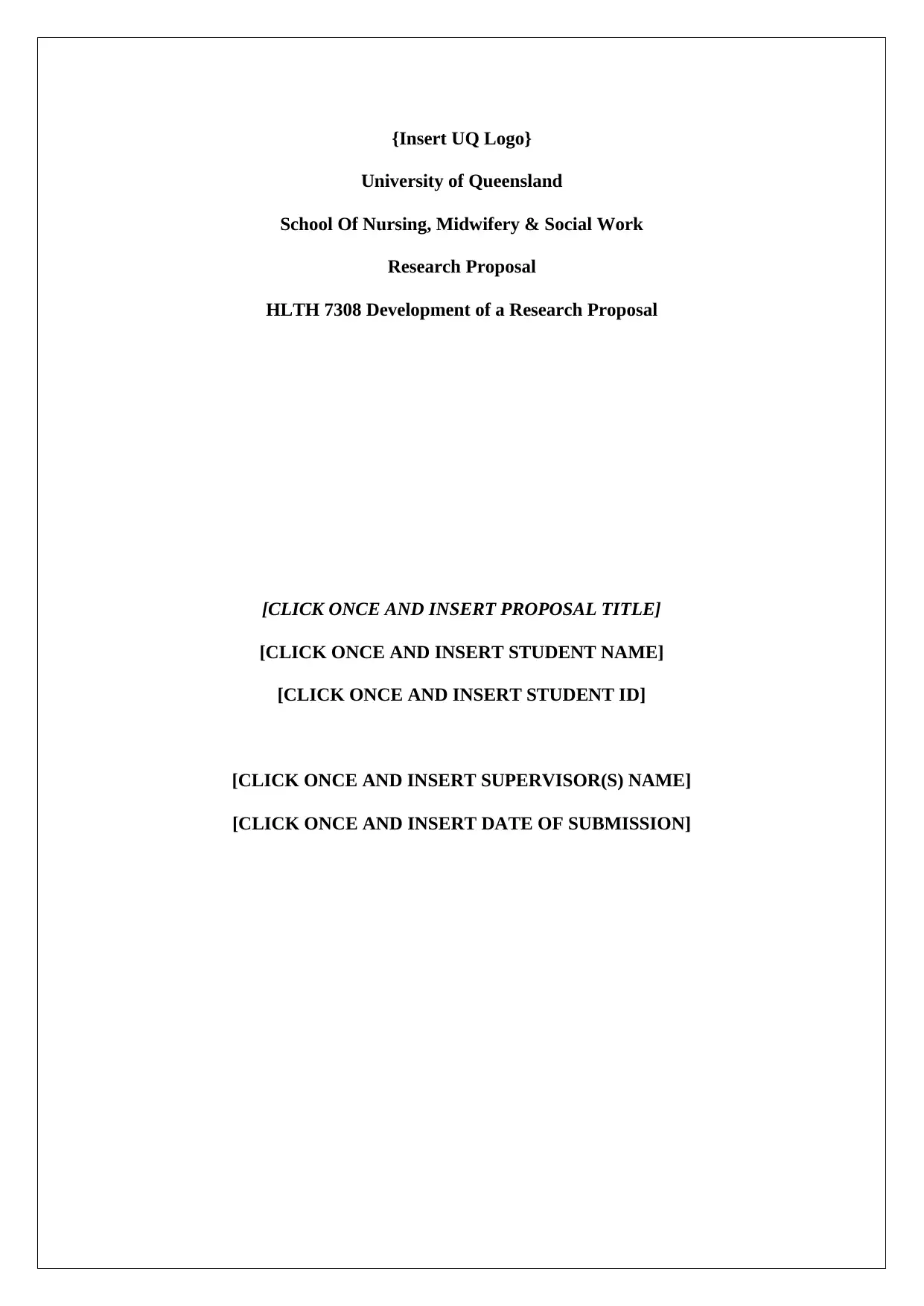
{Insert UQ Logo}
University of Queensland
School Of Nursing, Midwifery & Social Work
Research Proposal
HLTH 7308 Development of a Research Proposal
[CLICK ONCE AND INSERT PROPOSAL TITLE]
[CLICK ONCE AND INSERT STUDENT NAME]
[CLICK ONCE AND INSERT STUDENT ID]
[CLICK ONCE AND INSERT SUPERVISOR(S) NAME]
[CLICK ONCE AND INSERT DATE OF SUBMISSION]
University of Queensland
School Of Nursing, Midwifery & Social Work
Research Proposal
HLTH 7308 Development of a Research Proposal
[CLICK ONCE AND INSERT PROPOSAL TITLE]
[CLICK ONCE AND INSERT STUDENT NAME]
[CLICK ONCE AND INSERT STUDENT ID]
[CLICK ONCE AND INSERT SUPERVISOR(S) NAME]
[CLICK ONCE AND INSERT DATE OF SUBMISSION]
Paraphrase This Document
Need a fresh take? Get an instant paraphrase of this document with our AI Paraphraser
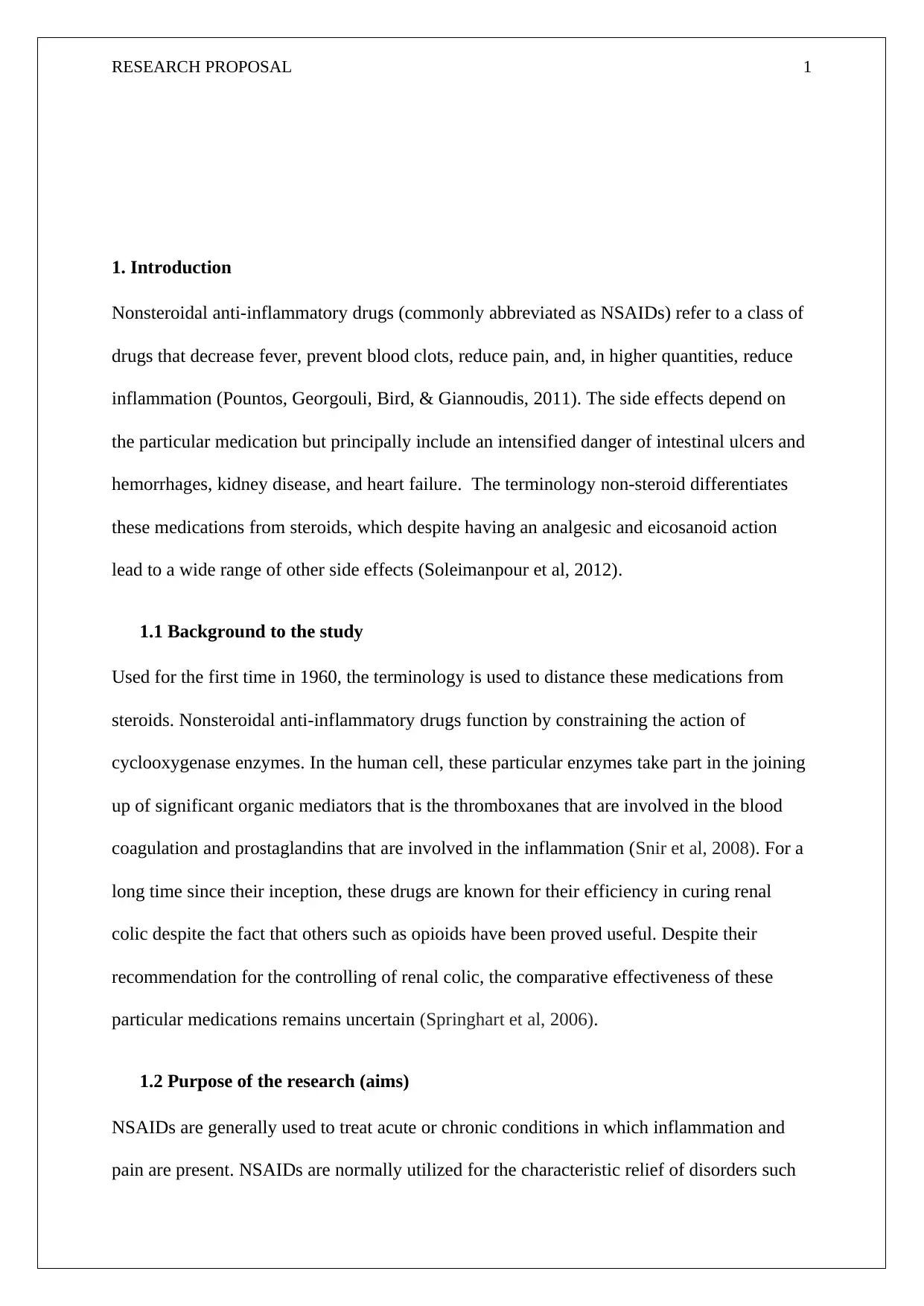
RESEARCH PROPOSAL 1
1. Introduction
Nonsteroidal anti-inflammatory drugs (commonly abbreviated as NSAIDs) refer to a class of
drugs that decrease fever, prevent blood clots, reduce pain, and, in higher quantities, reduce
inflammation (Pountos, Georgouli, Bird, & Giannoudis, 2011). The side effects depend on
the particular medication but principally include an intensified danger of intestinal ulcers and
hemorrhages, kidney disease, and heart failure. The terminology non-steroid differentiates
these medications from steroids, which despite having an analgesic and eicosanoid action
lead to a wide range of other side effects (Soleimanpour et al, 2012).
1.1 Background to the study
Used for the first time in 1960, the terminology is used to distance these medications from
steroids. Nonsteroidal anti-inflammatory drugs function by constraining the action of
cyclooxygenase enzymes. In the human cell, these particular enzymes take part in the joining
up of significant organic mediators that is the thromboxanes that are involved in the blood
coagulation and prostaglandins that are involved in the inflammation (Snir et al, 2008). For a
long time since their inception, these drugs are known for their efficiency in curing renal
colic despite the fact that others such as opioids have been proved useful. Despite their
recommendation for the controlling of renal colic, the comparative effectiveness of these
particular medications remains uncertain (Springhart et al, 2006).
1.2 Purpose of the research (aims)
NSAIDs are generally used to treat acute or chronic conditions in which inflammation and
pain are present. NSAIDs are normally utilized for the characteristic relief of disorders such
1. Introduction
Nonsteroidal anti-inflammatory drugs (commonly abbreviated as NSAIDs) refer to a class of
drugs that decrease fever, prevent blood clots, reduce pain, and, in higher quantities, reduce
inflammation (Pountos, Georgouli, Bird, & Giannoudis, 2011). The side effects depend on
the particular medication but principally include an intensified danger of intestinal ulcers and
hemorrhages, kidney disease, and heart failure. The terminology non-steroid differentiates
these medications from steroids, which despite having an analgesic and eicosanoid action
lead to a wide range of other side effects (Soleimanpour et al, 2012).
1.1 Background to the study
Used for the first time in 1960, the terminology is used to distance these medications from
steroids. Nonsteroidal anti-inflammatory drugs function by constraining the action of
cyclooxygenase enzymes. In the human cell, these particular enzymes take part in the joining
up of significant organic mediators that is the thromboxanes that are involved in the blood
coagulation and prostaglandins that are involved in the inflammation (Snir et al, 2008). For a
long time since their inception, these drugs are known for their efficiency in curing renal
colic despite the fact that others such as opioids have been proved useful. Despite their
recommendation for the controlling of renal colic, the comparative effectiveness of these
particular medications remains uncertain (Springhart et al, 2006).
1.2 Purpose of the research (aims)
NSAIDs are generally used to treat acute or chronic conditions in which inflammation and
pain are present. NSAIDs are normally utilized for the characteristic relief of disorders such
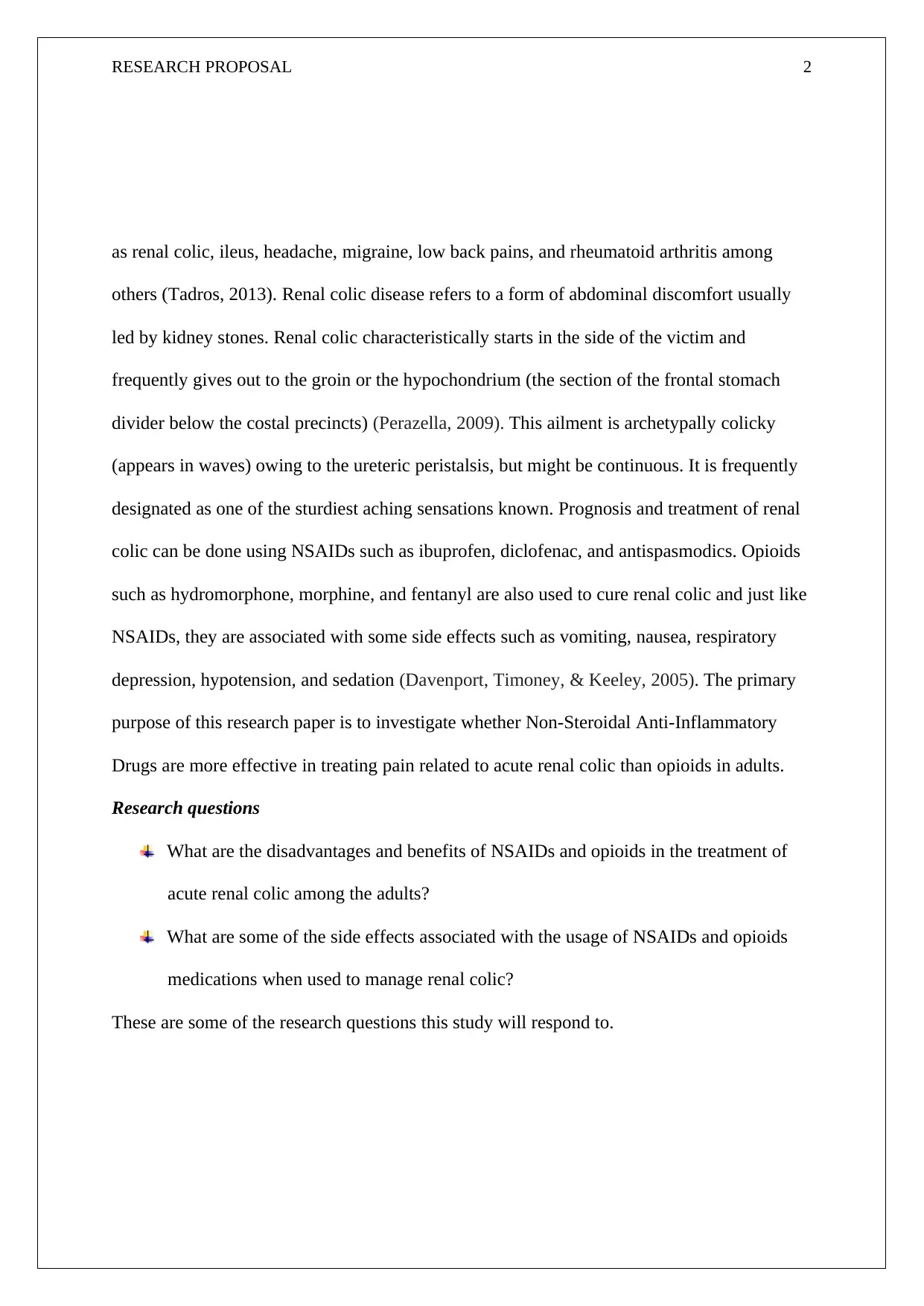
RESEARCH PROPOSAL 2
as renal colic, ileus, headache, migraine, low back pains, and rheumatoid arthritis among
others (Tadros, 2013). Renal colic disease refers to a form of abdominal discomfort usually
led by kidney stones. Renal colic characteristically starts in the side of the victim and
frequently gives out to the groin or the hypochondrium (the section of the frontal stomach
divider below the costal precincts) (Perazella, 2009). This ailment is archetypally colicky
(appears in waves) owing to the ureteric peristalsis, but might be continuous. It is frequently
designated as one of the sturdiest aching sensations known. Prognosis and treatment of renal
colic can be done using NSAIDs such as ibuprofen, diclofenac, and antispasmodics. Opioids
such as hydromorphone, morphine, and fentanyl are also used to cure renal colic and just like
NSAIDs, they are associated with some side effects such as vomiting, nausea, respiratory
depression, hypotension, and sedation (Davenport, Timoney, & Keeley, 2005). The primary
purpose of this research paper is to investigate whether Non-Steroidal Anti-Inflammatory
Drugs are more effective in treating pain related to acute renal colic than opioids in adults.
Research questions
What are the disadvantages and benefits of NSAIDs and opioids in the treatment of
acute renal colic among the adults?
What are some of the side effects associated with the usage of NSAIDs and opioids
medications when used to manage renal colic?
These are some of the research questions this study will respond to.
as renal colic, ileus, headache, migraine, low back pains, and rheumatoid arthritis among
others (Tadros, 2013). Renal colic disease refers to a form of abdominal discomfort usually
led by kidney stones. Renal colic characteristically starts in the side of the victim and
frequently gives out to the groin or the hypochondrium (the section of the frontal stomach
divider below the costal precincts) (Perazella, 2009). This ailment is archetypally colicky
(appears in waves) owing to the ureteric peristalsis, but might be continuous. It is frequently
designated as one of the sturdiest aching sensations known. Prognosis and treatment of renal
colic can be done using NSAIDs such as ibuprofen, diclofenac, and antispasmodics. Opioids
such as hydromorphone, morphine, and fentanyl are also used to cure renal colic and just like
NSAIDs, they are associated with some side effects such as vomiting, nausea, respiratory
depression, hypotension, and sedation (Davenport, Timoney, & Keeley, 2005). The primary
purpose of this research paper is to investigate whether Non-Steroidal Anti-Inflammatory
Drugs are more effective in treating pain related to acute renal colic than opioids in adults.
Research questions
What are the disadvantages and benefits of NSAIDs and opioids in the treatment of
acute renal colic among the adults?
What are some of the side effects associated with the usage of NSAIDs and opioids
medications when used to manage renal colic?
These are some of the research questions this study will respond to.
⊘ This is a preview!⊘
Do you want full access?
Subscribe today to unlock all pages.

Trusted by 1+ million students worldwide
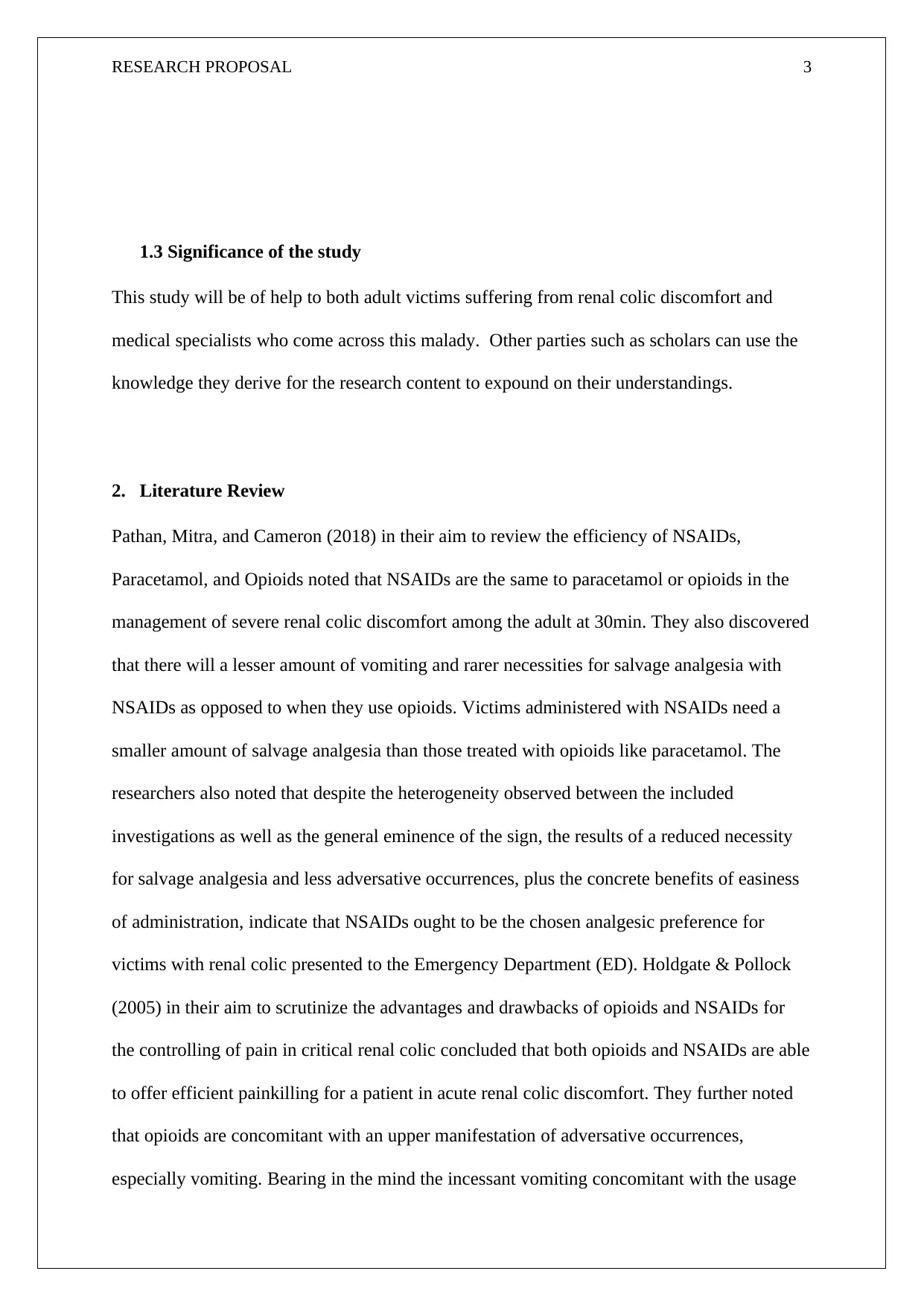
RESEARCH PROPOSAL 3
1.3 Significance of the study
This study will be of help to both adult victims suffering from renal colic discomfort and
medical specialists who come across this malady. Other parties such as scholars can use the
knowledge they derive for the research content to expound on their understandings.
2. Literature Review
Pathan, Mitra, and Cameron (2018) in their aim to review the efficiency of NSAIDs,
Paracetamol, and Opioids noted that NSAIDs are the same to paracetamol or opioids in the
management of severe renal colic discomfort among the adult at 30min. They also discovered
that there will a lesser amount of vomiting and rarer necessities for salvage analgesia with
NSAIDs as opposed to when they use opioids. Victims administered with NSAIDs need a
smaller amount of salvage analgesia than those treated with opioids like paracetamol. The
researchers also noted that despite the heterogeneity observed between the included
investigations as well as the general eminence of the sign, the results of a reduced necessity
for salvage analgesia and less adversative occurrences, plus the concrete benefits of easiness
of administration, indicate that NSAIDs ought to be the chosen analgesic preference for
victims with renal colic presented to the Emergency Department (ED). Holdgate & Pollock
(2005) in their aim to scrutinize the advantages and drawbacks of opioids and NSAIDs for
the controlling of pain in critical renal colic concluded that both opioids and NSAIDs are able
to offer efficient painkilling for a patient in acute renal colic discomfort. They further noted
that opioids are concomitant with an upper manifestation of adversative occurrences,
especially vomiting. Bearing in the mind the incessant vomiting concomitant with the usage
1.3 Significance of the study
This study will be of help to both adult victims suffering from renal colic discomfort and
medical specialists who come across this malady. Other parties such as scholars can use the
knowledge they derive for the research content to expound on their understandings.
2. Literature Review
Pathan, Mitra, and Cameron (2018) in their aim to review the efficiency of NSAIDs,
Paracetamol, and Opioids noted that NSAIDs are the same to paracetamol or opioids in the
management of severe renal colic discomfort among the adult at 30min. They also discovered
that there will a lesser amount of vomiting and rarer necessities for salvage analgesia with
NSAIDs as opposed to when they use opioids. Victims administered with NSAIDs need a
smaller amount of salvage analgesia than those treated with opioids like paracetamol. The
researchers also noted that despite the heterogeneity observed between the included
investigations as well as the general eminence of the sign, the results of a reduced necessity
for salvage analgesia and less adversative occurrences, plus the concrete benefits of easiness
of administration, indicate that NSAIDs ought to be the chosen analgesic preference for
victims with renal colic presented to the Emergency Department (ED). Holdgate & Pollock
(2005) in their aim to scrutinize the advantages and drawbacks of opioids and NSAIDs for
the controlling of pain in critical renal colic concluded that both opioids and NSAIDs are able
to offer efficient painkilling for a patient in acute renal colic discomfort. They further noted
that opioids are concomitant with an upper manifestation of adversative occurrences,
especially vomiting. Bearing in the mind the incessant vomiting concomitant with the usage
Paraphrase This Document
Need a fresh take? Get an instant paraphrase of this document with our AI Paraphraser
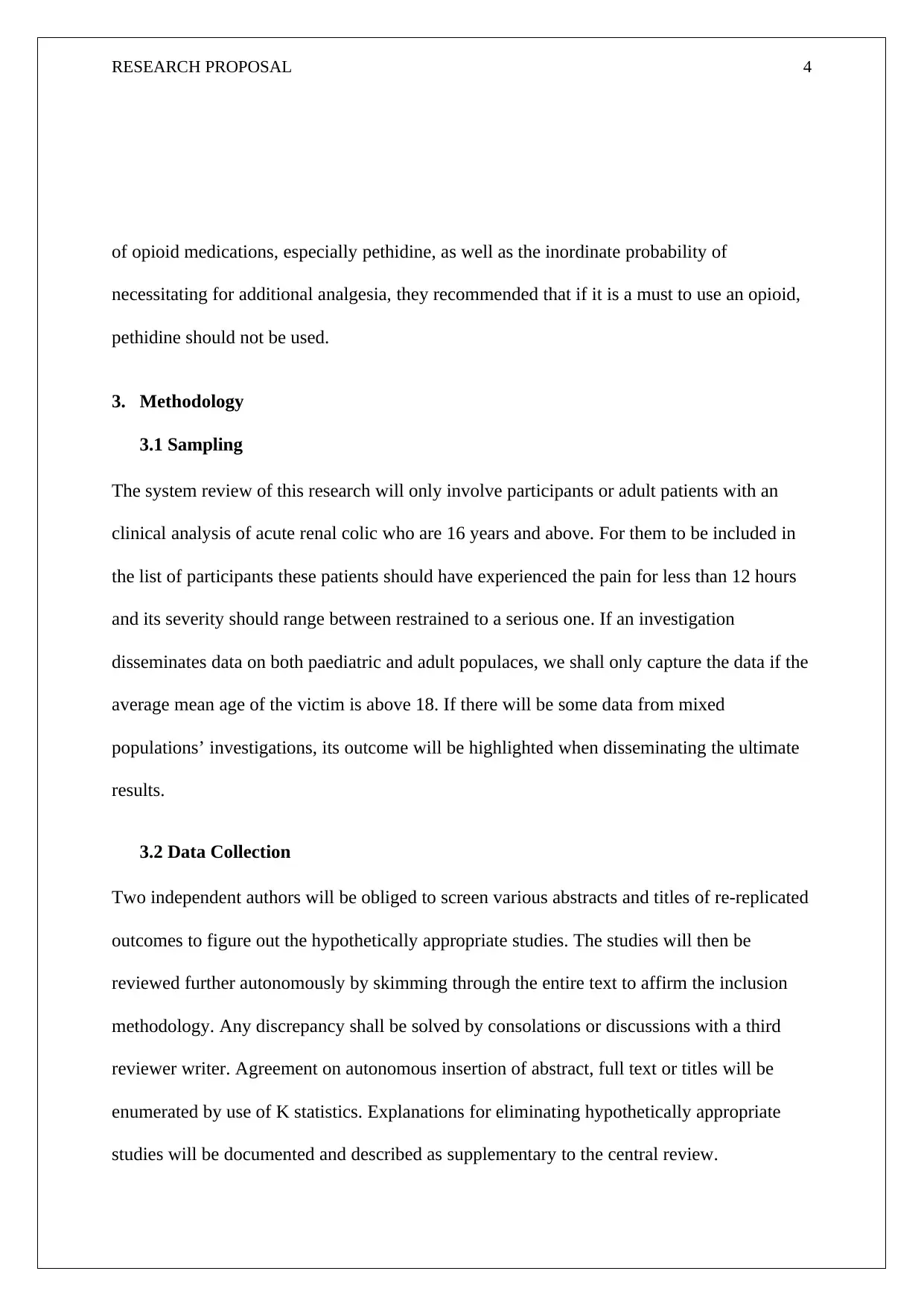
RESEARCH PROPOSAL 4
of opioid medications, especially pethidine, as well as the inordinate probability of
necessitating for additional analgesia, they recommended that if it is a must to use an opioid,
pethidine should not be used.
3. Methodology
3.1 Sampling
The system review of this research will only involve participants or adult patients with an
clinical analysis of acute renal colic who are 16 years and above. For them to be included in
the list of participants these patients should have experienced the pain for less than 12 hours
and its severity should range between restrained to a serious one. If an investigation
disseminates data on both paediatric and adult populaces, we shall only capture the data if the
average mean age of the victim is above 18. If there will be some data from mixed
populations’ investigations, its outcome will be highlighted when disseminating the ultimate
results.
3.2 Data Collection
Two independent authors will be obliged to screen various abstracts and titles of re-replicated
outcomes to figure out the hypothetically appropriate studies. The studies will then be
reviewed further autonomously by skimming through the entire text to affirm the inclusion
methodology. Any discrepancy shall be solved by consolations or discussions with a third
reviewer writer. Agreement on autonomous insertion of abstract, full text or titles will be
enumerated by use of K statistics. Explanations for eliminating hypothetically appropriate
studies will be documented and described as supplementary to the central review.
of opioid medications, especially pethidine, as well as the inordinate probability of
necessitating for additional analgesia, they recommended that if it is a must to use an opioid,
pethidine should not be used.
3. Methodology
3.1 Sampling
The system review of this research will only involve participants or adult patients with an
clinical analysis of acute renal colic who are 16 years and above. For them to be included in
the list of participants these patients should have experienced the pain for less than 12 hours
and its severity should range between restrained to a serious one. If an investigation
disseminates data on both paediatric and adult populaces, we shall only capture the data if the
average mean age of the victim is above 18. If there will be some data from mixed
populations’ investigations, its outcome will be highlighted when disseminating the ultimate
results.
3.2 Data Collection
Two independent authors will be obliged to screen various abstracts and titles of re-replicated
outcomes to figure out the hypothetically appropriate studies. The studies will then be
reviewed further autonomously by skimming through the entire text to affirm the inclusion
methodology. Any discrepancy shall be solved by consolations or discussions with a third
reviewer writer. Agreement on autonomous insertion of abstract, full text or titles will be
enumerated by use of K statistics. Explanations for eliminating hypothetically appropriate
studies will be documented and described as supplementary to the central review.
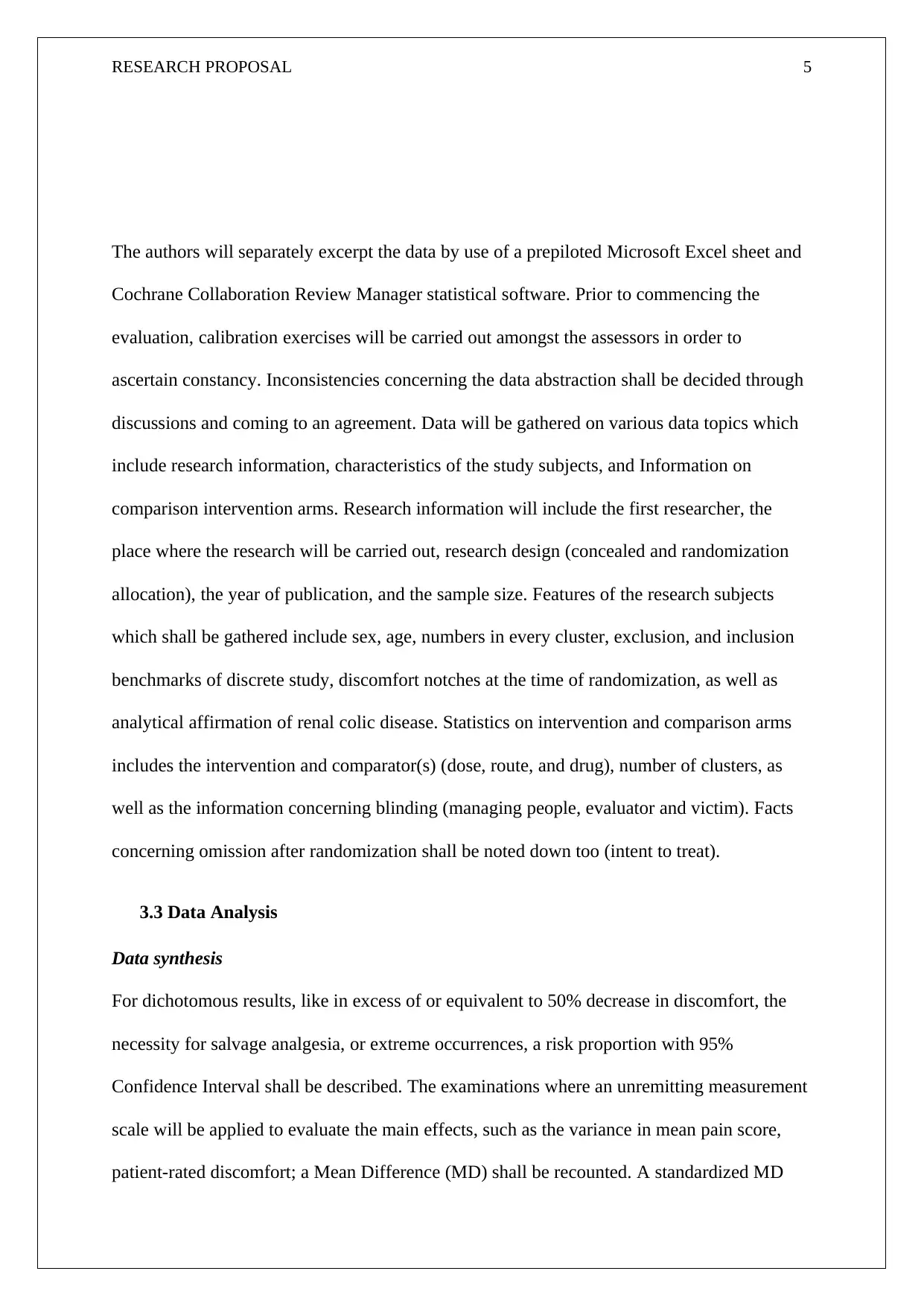
RESEARCH PROPOSAL 5
The authors will separately excerpt the data by use of a prepiloted Microsoft Excel sheet and
Cochrane Collaboration Review Manager statistical software. Prior to commencing the
evaluation, calibration exercises will be carried out amongst the assessors in order to
ascertain constancy. Inconsistencies concerning the data abstraction shall be decided through
discussions and coming to an agreement. Data will be gathered on various data topics which
include research information, characteristics of the study subjects, and Information on
comparison intervention arms. Research information will include the first researcher, the
place where the research will be carried out, research design (concealed and randomization
allocation), the year of publication, and the sample size. Features of the research subjects
which shall be gathered include sex, age, numbers in every cluster, exclusion, and inclusion
benchmarks of discrete study, discomfort notches at the time of randomization, as well as
analytical affirmation of renal colic disease. Statistics on intervention and comparison arms
includes the intervention and comparator(s) (dose, route, and drug), number of clusters, as
well as the information concerning blinding (managing people, evaluator and victim). Facts
concerning omission after randomization shall be noted down too (intent to treat).
3.3 Data Analysis
Data synthesis
For dichotomous results, like in excess of or equivalent to 50% decrease in discomfort, the
necessity for salvage analgesia, or extreme occurrences, a risk proportion with 95%
Confidence Interval shall be described. The examinations where an unremitting measurement
scale will be applied to evaluate the main effects, such as the variance in mean pain score,
patient-rated discomfort; a Mean Difference (MD) shall be recounted. A standardized MD
The authors will separately excerpt the data by use of a prepiloted Microsoft Excel sheet and
Cochrane Collaboration Review Manager statistical software. Prior to commencing the
evaluation, calibration exercises will be carried out amongst the assessors in order to
ascertain constancy. Inconsistencies concerning the data abstraction shall be decided through
discussions and coming to an agreement. Data will be gathered on various data topics which
include research information, characteristics of the study subjects, and Information on
comparison intervention arms. Research information will include the first researcher, the
place where the research will be carried out, research design (concealed and randomization
allocation), the year of publication, and the sample size. Features of the research subjects
which shall be gathered include sex, age, numbers in every cluster, exclusion, and inclusion
benchmarks of discrete study, discomfort notches at the time of randomization, as well as
analytical affirmation of renal colic disease. Statistics on intervention and comparison arms
includes the intervention and comparator(s) (dose, route, and drug), number of clusters, as
well as the information concerning blinding (managing people, evaluator and victim). Facts
concerning omission after randomization shall be noted down too (intent to treat).
3.3 Data Analysis
Data synthesis
For dichotomous results, like in excess of or equivalent to 50% decrease in discomfort, the
necessity for salvage analgesia, or extreme occurrences, a risk proportion with 95%
Confidence Interval shall be described. The examinations where an unremitting measurement
scale will be applied to evaluate the main effects, such as the variance in mean pain score,
patient-rated discomfort; a Mean Difference (MD) shall be recounted. A standardized MD
⊘ This is a preview!⊘
Do you want full access?
Subscribe today to unlock all pages.

Trusted by 1+ million students worldwide
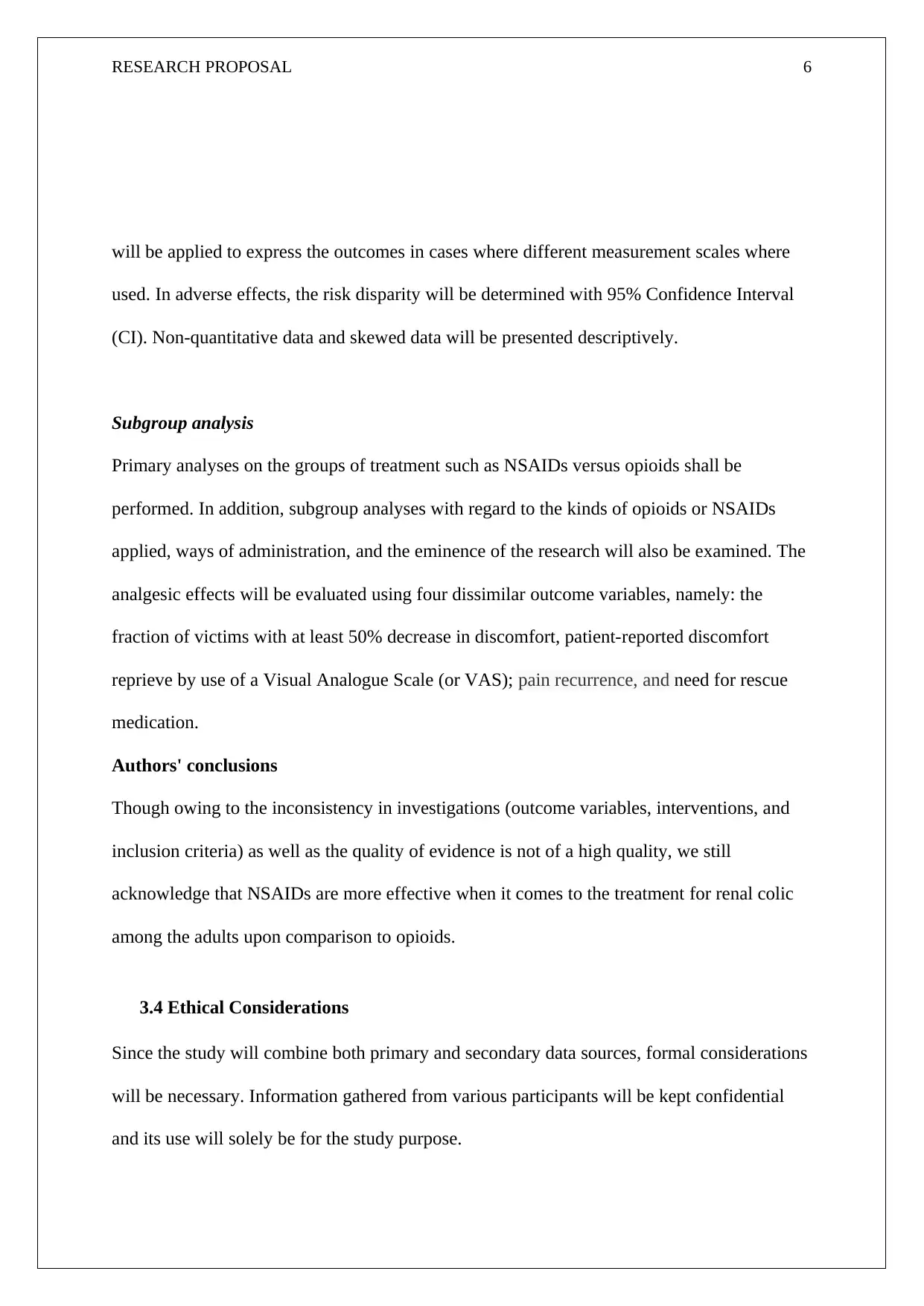
RESEARCH PROPOSAL 6
will be applied to express the outcomes in cases where different measurement scales where
used. In adverse effects, the risk disparity will be determined with 95% Confidence Interval
(CI). Non-quantitative data and skewed data will be presented descriptively.
Subgroup analysis
Primary analyses on the groups of treatment such as NSAIDs versus opioids shall be
performed. In addition, subgroup analyses with regard to the kinds of opioids or NSAIDs
applied, ways of administration, and the eminence of the research will also be examined. The
analgesic effects will be evaluated using four dissimilar outcome variables, namely: the
fraction of victims with at least 50% decrease in discomfort, patient-reported discomfort
reprieve by use of a Visual Analogue Scale (or VAS); pain recurrence, and need for rescue
medication.
Authors' conclusions
Though owing to the inconsistency in investigations (outcome variables, interventions, and
inclusion criteria) as well as the quality of evidence is not of a high quality, we still
acknowledge that NSAIDs are more effective when it comes to the treatment for renal colic
among the adults upon comparison to opioids.
3.4 Ethical Considerations
Since the study will combine both primary and secondary data sources, formal considerations
will be necessary. Information gathered from various participants will be kept confidential
and its use will solely be for the study purpose.
will be applied to express the outcomes in cases where different measurement scales where
used. In adverse effects, the risk disparity will be determined with 95% Confidence Interval
(CI). Non-quantitative data and skewed data will be presented descriptively.
Subgroup analysis
Primary analyses on the groups of treatment such as NSAIDs versus opioids shall be
performed. In addition, subgroup analyses with regard to the kinds of opioids or NSAIDs
applied, ways of administration, and the eminence of the research will also be examined. The
analgesic effects will be evaluated using four dissimilar outcome variables, namely: the
fraction of victims with at least 50% decrease in discomfort, patient-reported discomfort
reprieve by use of a Visual Analogue Scale (or VAS); pain recurrence, and need for rescue
medication.
Authors' conclusions
Though owing to the inconsistency in investigations (outcome variables, interventions, and
inclusion criteria) as well as the quality of evidence is not of a high quality, we still
acknowledge that NSAIDs are more effective when it comes to the treatment for renal colic
among the adults upon comparison to opioids.
3.4 Ethical Considerations
Since the study will combine both primary and secondary data sources, formal considerations
will be necessary. Information gathered from various participants will be kept confidential
and its use will solely be for the study purpose.
Paraphrase This Document
Need a fresh take? Get an instant paraphrase of this document with our AI Paraphraser
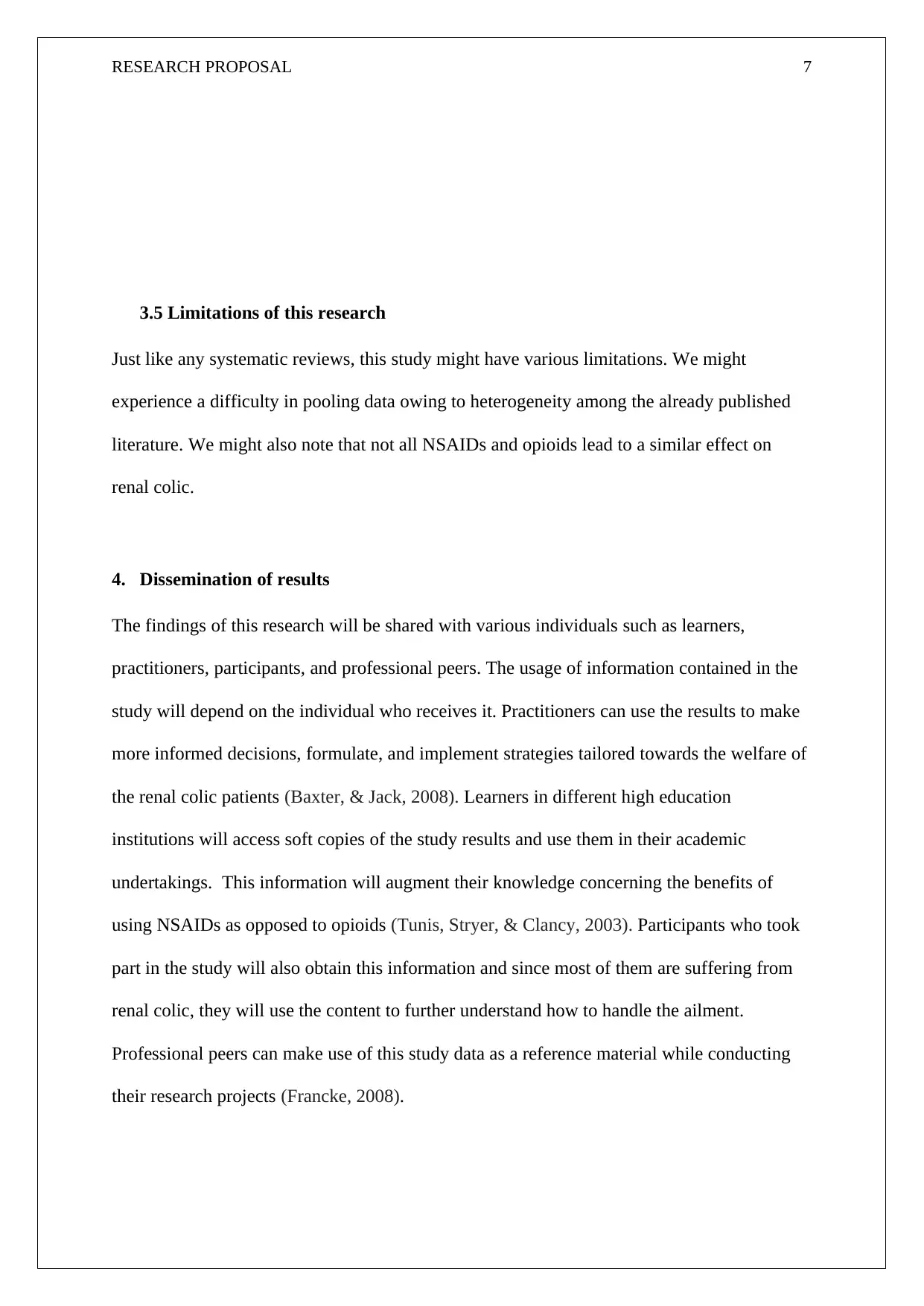
RESEARCH PROPOSAL 7
3.5 Limitations of this research
Just like any systematic reviews, this study might have various limitations. We might
experience a difficulty in pooling data owing to heterogeneity among the already published
literature. We might also note that not all NSAIDs and opioids lead to a similar effect on
renal colic.
4. Dissemination of results
The findings of this research will be shared with various individuals such as learners,
practitioners, participants, and professional peers. The usage of information contained in the
study will depend on the individual who receives it. Practitioners can use the results to make
more informed decisions, formulate, and implement strategies tailored towards the welfare of
the renal colic patients (Baxter, & Jack, 2008). Learners in different high education
institutions will access soft copies of the study results and use them in their academic
undertakings. This information will augment their knowledge concerning the benefits of
using NSAIDs as opposed to opioids (Tunis, Stryer, & Clancy, 2003). Participants who took
part in the study will also obtain this information and since most of them are suffering from
renal colic, they will use the content to further understand how to handle the ailment.
Professional peers can make use of this study data as a reference material while conducting
their research projects (Francke, 2008).
3.5 Limitations of this research
Just like any systematic reviews, this study might have various limitations. We might
experience a difficulty in pooling data owing to heterogeneity among the already published
literature. We might also note that not all NSAIDs and opioids lead to a similar effect on
renal colic.
4. Dissemination of results
The findings of this research will be shared with various individuals such as learners,
practitioners, participants, and professional peers. The usage of information contained in the
study will depend on the individual who receives it. Practitioners can use the results to make
more informed decisions, formulate, and implement strategies tailored towards the welfare of
the renal colic patients (Baxter, & Jack, 2008). Learners in different high education
institutions will access soft copies of the study results and use them in their academic
undertakings. This information will augment their knowledge concerning the benefits of
using NSAIDs as opposed to opioids (Tunis, Stryer, & Clancy, 2003). Participants who took
part in the study will also obtain this information and since most of them are suffering from
renal colic, they will use the content to further understand how to handle the ailment.
Professional peers can make use of this study data as a reference material while conducting
their research projects (Francke, 2008).
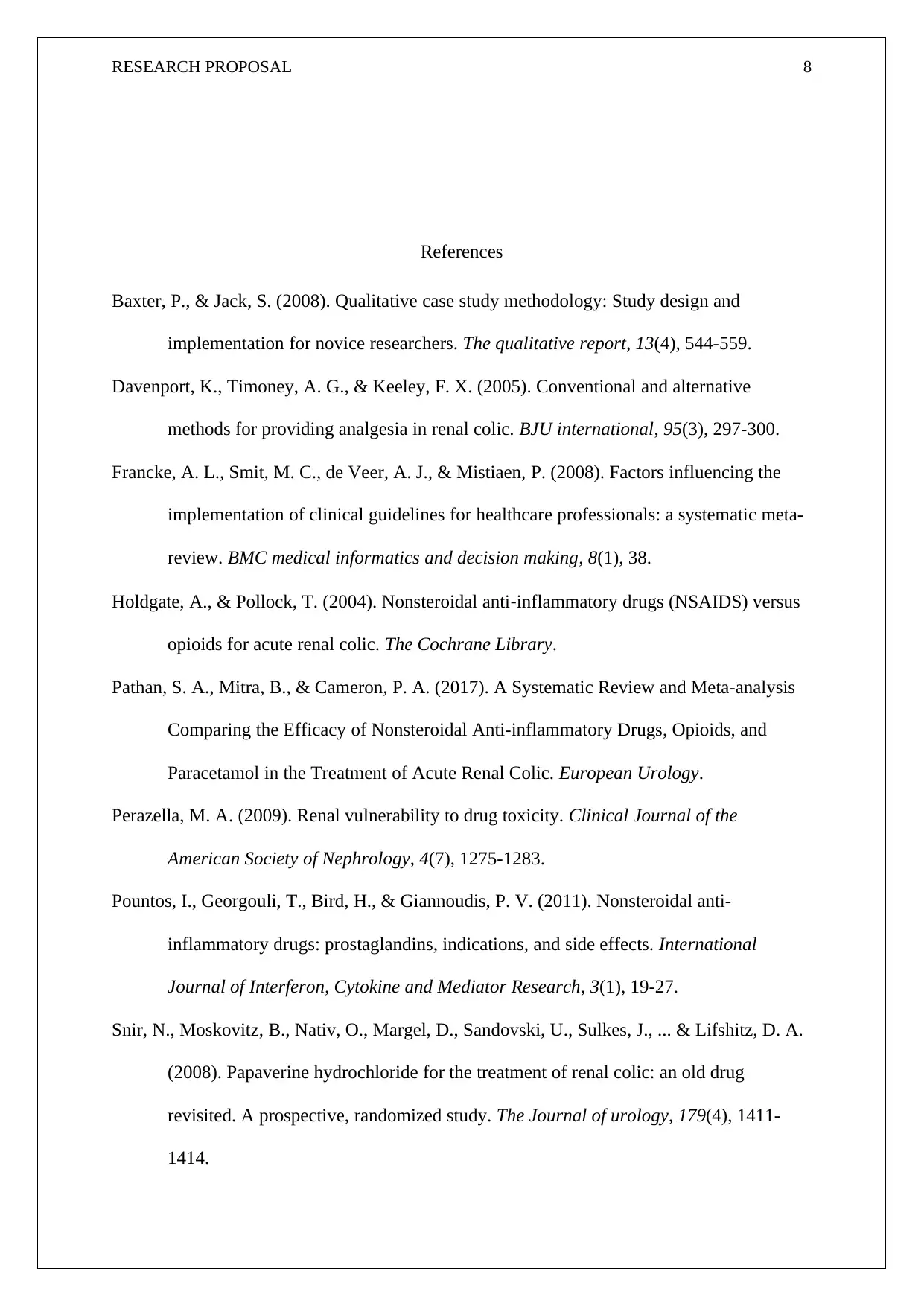
RESEARCH PROPOSAL 8
References
Baxter, P., & Jack, S. (2008). Qualitative case study methodology: Study design and
implementation for novice researchers. The qualitative report, 13(4), 544-559.
Davenport, K., Timoney, A. G., & Keeley, F. X. (2005). Conventional and alternative
methods for providing analgesia in renal colic. BJU international, 95(3), 297-300.
Francke, A. L., Smit, M. C., de Veer, A. J., & Mistiaen, P. (2008). Factors influencing the
implementation of clinical guidelines for healthcare professionals: a systematic meta-
review. BMC medical informatics and decision making, 8(1), 38.
Holdgate, A., & Pollock, T. (2004). Nonsteroidal anti‐inflammatory drugs (NSAIDS) versus
opioids for acute renal colic. The Cochrane Library.
Pathan, S. A., Mitra, B., & Cameron, P. A. (2017). A Systematic Review and Meta-analysis
Comparing the Efficacy of Nonsteroidal Anti-inflammatory Drugs, Opioids, and
Paracetamol in the Treatment of Acute Renal Colic. European Urology.
Perazella, M. A. (2009). Renal vulnerability to drug toxicity. Clinical Journal of the
American Society of Nephrology, 4(7), 1275-1283.
Pountos, I., Georgouli, T., Bird, H., & Giannoudis, P. V. (2011). Nonsteroidal anti-
inflammatory drugs: prostaglandins, indications, and side effects. International
Journal of Interferon, Cytokine and Mediator Research, 3(1), 19-27.
Snir, N., Moskovitz, B., Nativ, O., Margel, D., Sandovski, U., Sulkes, J., ... & Lifshitz, D. A.
(2008). Papaverine hydrochloride for the treatment of renal colic: an old drug
revisited. A prospective, randomized study. The Journal of urology, 179(4), 1411-
1414.
References
Baxter, P., & Jack, S. (2008). Qualitative case study methodology: Study design and
implementation for novice researchers. The qualitative report, 13(4), 544-559.
Davenport, K., Timoney, A. G., & Keeley, F. X. (2005). Conventional and alternative
methods for providing analgesia in renal colic. BJU international, 95(3), 297-300.
Francke, A. L., Smit, M. C., de Veer, A. J., & Mistiaen, P. (2008). Factors influencing the
implementation of clinical guidelines for healthcare professionals: a systematic meta-
review. BMC medical informatics and decision making, 8(1), 38.
Holdgate, A., & Pollock, T. (2004). Nonsteroidal anti‐inflammatory drugs (NSAIDS) versus
opioids for acute renal colic. The Cochrane Library.
Pathan, S. A., Mitra, B., & Cameron, P. A. (2017). A Systematic Review and Meta-analysis
Comparing the Efficacy of Nonsteroidal Anti-inflammatory Drugs, Opioids, and
Paracetamol in the Treatment of Acute Renal Colic. European Urology.
Perazella, M. A. (2009). Renal vulnerability to drug toxicity. Clinical Journal of the
American Society of Nephrology, 4(7), 1275-1283.
Pountos, I., Georgouli, T., Bird, H., & Giannoudis, P. V. (2011). Nonsteroidal anti-
inflammatory drugs: prostaglandins, indications, and side effects. International
Journal of Interferon, Cytokine and Mediator Research, 3(1), 19-27.
Snir, N., Moskovitz, B., Nativ, O., Margel, D., Sandovski, U., Sulkes, J., ... & Lifshitz, D. A.
(2008). Papaverine hydrochloride for the treatment of renal colic: an old drug
revisited. A prospective, randomized study. The Journal of urology, 179(4), 1411-
1414.
⊘ This is a preview!⊘
Do you want full access?
Subscribe today to unlock all pages.

Trusted by 1+ million students worldwide
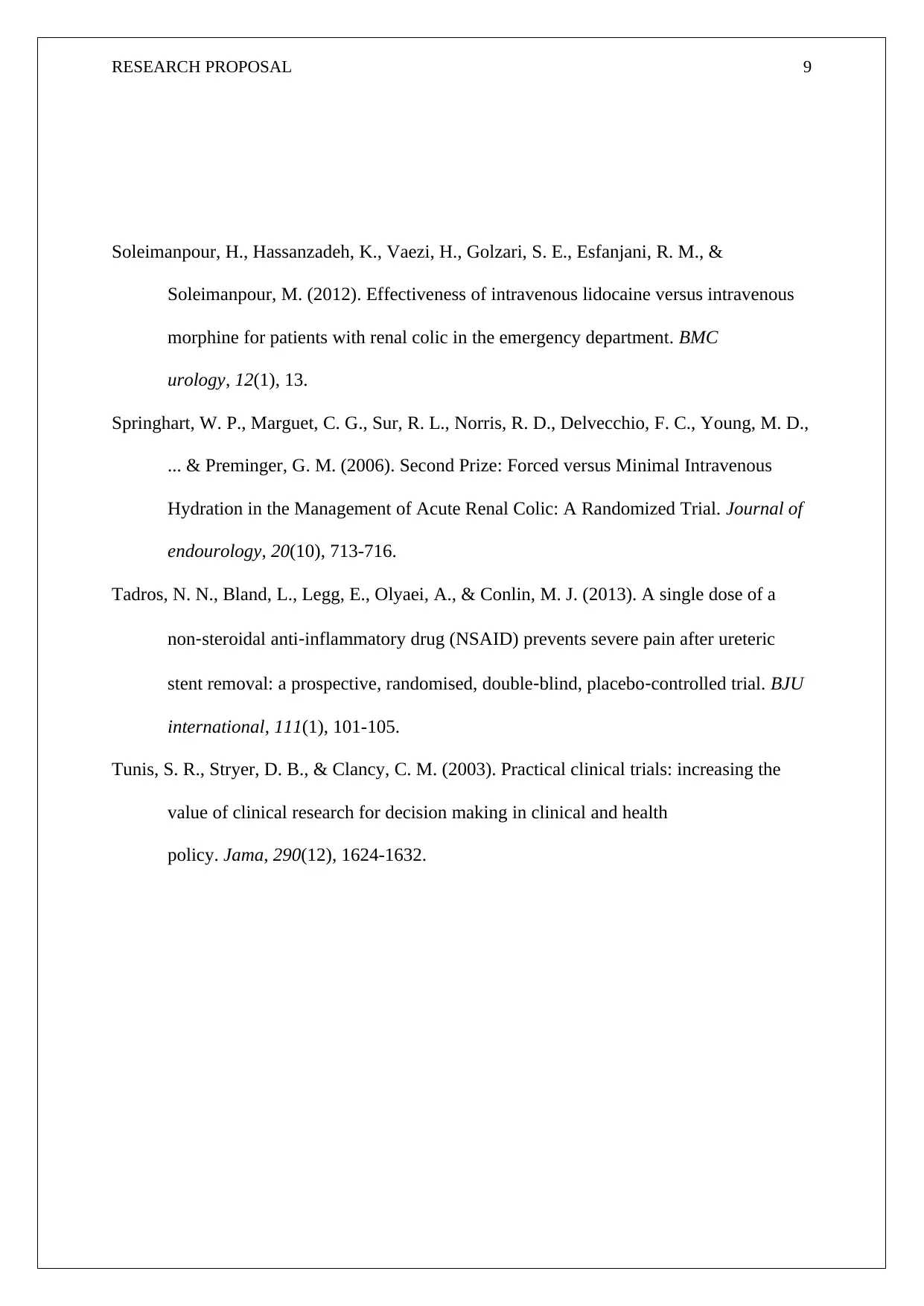
RESEARCH PROPOSAL 9
Soleimanpour, H., Hassanzadeh, K., Vaezi, H., Golzari, S. E., Esfanjani, R. M., &
Soleimanpour, M. (2012). Effectiveness of intravenous lidocaine versus intravenous
morphine for patients with renal colic in the emergency department. BMC
urology, 12(1), 13.
Springhart, W. P., Marguet, C. G., Sur, R. L., Norris, R. D., Delvecchio, F. C., Young, M. D.,
... & Preminger, G. M. (2006). Second Prize: Forced versus Minimal Intravenous
Hydration in the Management of Acute Renal Colic: A Randomized Trial. Journal of
endourology, 20(10), 713-716.
Tadros, N. N., Bland, L., Legg, E., Olyaei, A., & Conlin, M. J. (2013). A single dose of a
non‐steroidal anti‐inflammatory drug (NSAID) prevents severe pain after ureteric
stent removal: a prospective, randomised, double‐blind, placebo‐controlled trial. BJU
international, 111(1), 101-105.
Tunis, S. R., Stryer, D. B., & Clancy, C. M. (2003). Practical clinical trials: increasing the
value of clinical research for decision making in clinical and health
policy. Jama, 290(12), 1624-1632.
Soleimanpour, H., Hassanzadeh, K., Vaezi, H., Golzari, S. E., Esfanjani, R. M., &
Soleimanpour, M. (2012). Effectiveness of intravenous lidocaine versus intravenous
morphine for patients with renal colic in the emergency department. BMC
urology, 12(1), 13.
Springhart, W. P., Marguet, C. G., Sur, R. L., Norris, R. D., Delvecchio, F. C., Young, M. D.,
... & Preminger, G. M. (2006). Second Prize: Forced versus Minimal Intravenous
Hydration in the Management of Acute Renal Colic: A Randomized Trial. Journal of
endourology, 20(10), 713-716.
Tadros, N. N., Bland, L., Legg, E., Olyaei, A., & Conlin, M. J. (2013). A single dose of a
non‐steroidal anti‐inflammatory drug (NSAID) prevents severe pain after ureteric
stent removal: a prospective, randomised, double‐blind, placebo‐controlled trial. BJU
international, 111(1), 101-105.
Tunis, S. R., Stryer, D. B., & Clancy, C. M. (2003). Practical clinical trials: increasing the
value of clinical research for decision making in clinical and health
policy. Jama, 290(12), 1624-1632.
Paraphrase This Document
Need a fresh take? Get an instant paraphrase of this document with our AI Paraphraser
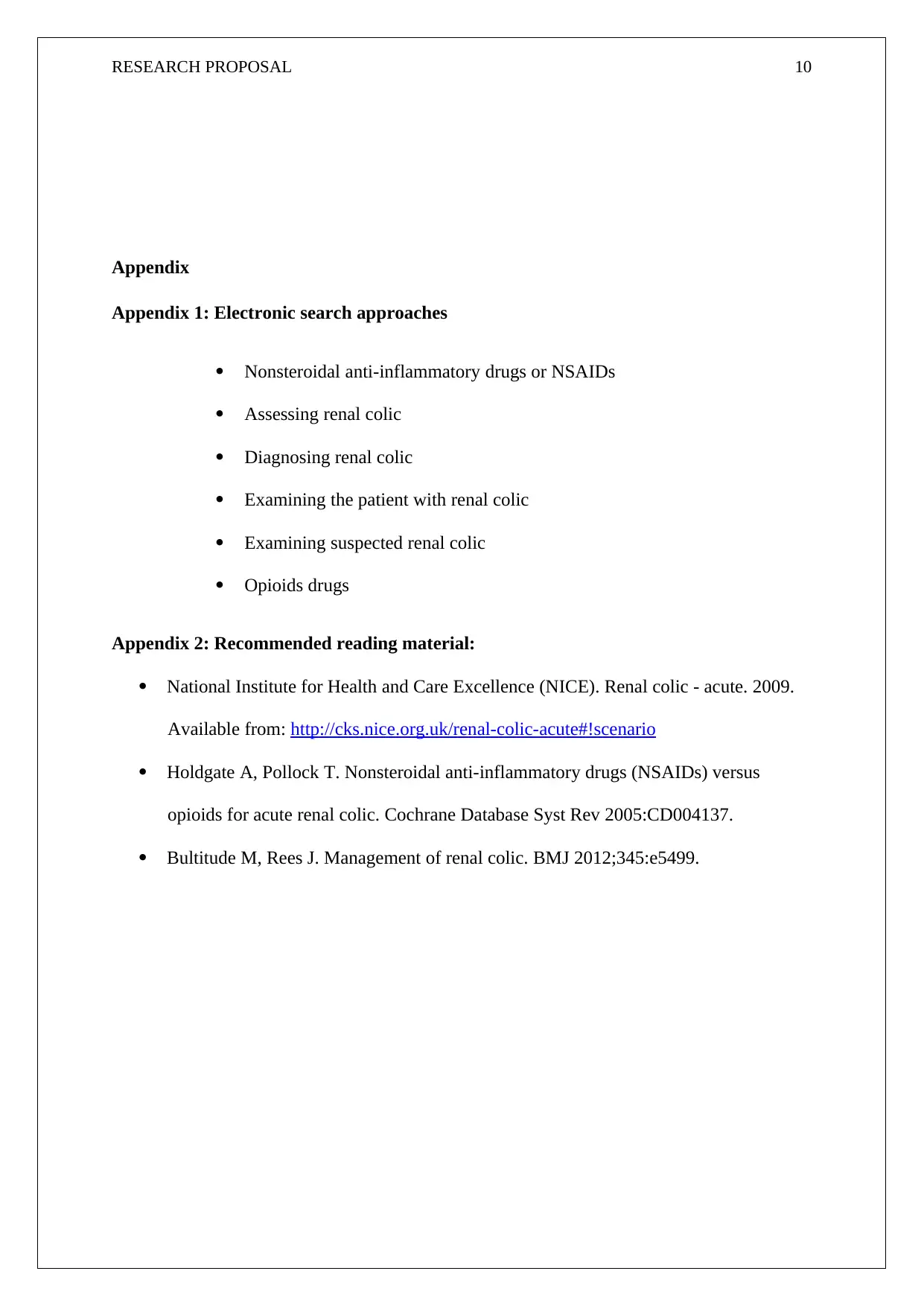
RESEARCH PROPOSAL 10
Appendix
Appendix 1: Electronic search approaches
Nonsteroidal anti-inflammatory drugs or NSAIDs
Assessing renal colic
Diagnosing renal colic
Examining the patient with renal colic
Examining suspected renal colic
Opioids drugs
Appendix 2: Recommended reading material:
National Institute for Health and Care Excellence (NICE). Renal colic - acute. 2009.
Available from: http://cks.nice.org.uk/renal-colic-acute#!scenario
Holdgate A, Pollock T. Nonsteroidal anti-inflammatory drugs (NSAIDs) versus
opioids for acute renal colic. Cochrane Database Syst Rev 2005:CD004137.
Bultitude M, Rees J. Management of renal colic. BMJ 2012;345:e5499.
Appendix
Appendix 1: Electronic search approaches
Nonsteroidal anti-inflammatory drugs or NSAIDs
Assessing renal colic
Diagnosing renal colic
Examining the patient with renal colic
Examining suspected renal colic
Opioids drugs
Appendix 2: Recommended reading material:
National Institute for Health and Care Excellence (NICE). Renal colic - acute. 2009.
Available from: http://cks.nice.org.uk/renal-colic-acute#!scenario
Holdgate A, Pollock T. Nonsteroidal anti-inflammatory drugs (NSAIDs) versus
opioids for acute renal colic. Cochrane Database Syst Rev 2005:CD004137.
Bultitude M, Rees J. Management of renal colic. BMJ 2012;345:e5499.
1 out of 11
Related Documents
Your All-in-One AI-Powered Toolkit for Academic Success.
+13062052269
info@desklib.com
Available 24*7 on WhatsApp / Email
![[object Object]](/_next/static/media/star-bottom.7253800d.svg)
Unlock your academic potential
Copyright © 2020–2025 A2Z Services. All Rights Reserved. Developed and managed by ZUCOL.





